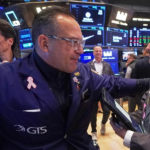Smart money watches ASML for signals on the tech cycle’s health; a growth warning here may be the market’s early clue that the AI and semiconductor supercycle is reaching a plateau—or at least preparing for turbulence.
So when ASML tells the market it “cannot confirm” growth for 2026—despite beating on current earnings—it’s signaling not just caution about its own pipeline, but a potential inflection point in the most future-critical segment of the electronics supply chain. In other words: if ASML’s order book slows, it means that downstream chipmakers may anticipate softer demand, have rising uncertainty about capex returns, or are bracing for policy headwinds.
The context matters: This is a moment when AI demand has been surging, but in 2025 it’s now colliding with macro uncertainty, particularly driven by U.S.-EU tariff threats, China export restrictions, and capex fatigue after a historic tech investment wave. ASML’s lead times are 12 to 18 months—with orders today reflecting confidence in global chip demand well into 2026. If that confidence is wavering, it ripples through the entire innovation economy.









